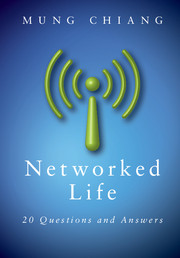Book contents
- Frontmatter
- Contents
- Preface
- Acknowledgements
- Roadmap
- 1 What makes CDMA work for my smartphone?
- 2 How does Google sell ad spaces?
- 3 How does Google rank webpages?
- 4 How does Netflix recommend movies?
- 5 When can I trust an average rating on Amazon?
- 6 Why does Wikipedia even work?
- 7 How do I viralize a YouTube video and tip a Groupon deal?
- 8 How do I influence people on Facebook and Twitter?
- 9 Can I really reach anyone in six steps?
- 10 Does the Internet have an Achilles' heel?
- 11 Why do AT&T and Verizon Wireless charge me $10 a GB?
- 12 How can I pay less for each GB?
- 13 How does traffic get through the Internet?
- 14 Why doesn't the Internet collapse under congestion?
- 15 How can Skype and Bit Torrent be free?
- 16 What's inside the cloud of iCloud?
- 17 IPTV and Netflix: How can the Internet support video?
- 18 Why is WiFi faster at home than at a hotspot?
- 19 Why am I getting only a few % of the advertised 4G speed?
- 20 Is it fair that my neighbor's iPad downloads faster?
- Index
- Notes
1 - What makes CDMA work for my smartphone?
Published online by Cambridge University Press: 05 November 2012
- Frontmatter
- Contents
- Preface
- Acknowledgements
- Roadmap
- 1 What makes CDMA work for my smartphone?
- 2 How does Google sell ad spaces?
- 3 How does Google rank webpages?
- 4 How does Netflix recommend movies?
- 5 When can I trust an average rating on Amazon?
- 6 Why does Wikipedia even work?
- 7 How do I viralize a YouTube video and tip a Groupon deal?
- 8 How do I influence people on Facebook and Twitter?
- 9 Can I really reach anyone in six steps?
- 10 Does the Internet have an Achilles' heel?
- 11 Why do AT&T and Verizon Wireless charge me $10 a GB?
- 12 How can I pay less for each GB?
- 13 How does traffic get through the Internet?
- 14 Why doesn't the Internet collapse under congestion?
- 15 How can Skype and Bit Torrent be free?
- 16 What's inside the cloud of iCloud?
- 17 IPTV and Netflix: How can the Internet support video?
- 18 Why is WiFi faster at home than at a hotspot?
- 19 Why am I getting only a few % of the advertised 4G speed?
- 20 Is it fair that my neighbor's iPad downloads faster?
- Index
- Notes
Summary
A Short Answer
Take a look at your iPhone, Android phone, or a smartphone running on some other operating system. It embodies a remarkable story of technology innovations. The rise of wireless networks, the Internet, and the web over the last five decades, coupled with advances in chip design, touchscreen material, battery packaging, software systems, business models… led to this amazing device you are holding in your hand. It symbolizes our age of networked life.
These phones have become the mobile, lightweight, smart centers of focus in our lives. They are used not just for voice calls, but also for data applications: texting, emailing, browsing the web, streaming videos, downloading books, uploading photos, playing games, or video-conferencing friends. The throughputs of these applications are measured in bits per second (bps). These data fly through a cellular network and the Internet. The cellular network in turn consists of the radio air-interface and the core network. We focus on the air-interface part in this chapter, and turn to the cellular core network in Chapter 19.
Terrestrial wireless communication started back in the 1940s, and cellular networks have gone through generations of evolution since the 1970s, moving into what we hear as 4G these days. Back in the 1980s, some estimated that there would be 1 million cellular users in the USA by 2000. That turned out to be one of those way-off under-estimates that did not even get close to the actual impact of networking technologies.
- Type
- Chapter
- Information
- Networked Life20 Questions and Answers, pp. 1 - 24Publisher: Cambridge University PressPrint publication year: 2012



